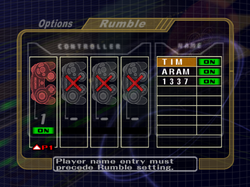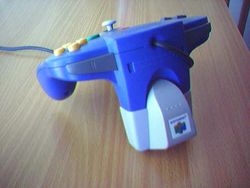Rumble: Difference between revisions
m (Undid edit by The Other Jared: 3DS?) Tag: Undo |
(Something I thought was interesting. Confirmation for other controllers, and whether this applies in 4, will be good.) |
||
| Line 27: | Line 27: | ||
</gallery> | </gallery> | ||
==Trivia== | ==Trivia== | ||
*In ''Ultimate'', the Joy-Cons will rumble as soon as the game determines that a hit has occurred. Due to the 6 frame display lag the game has, this means the Joy-Cons will rumble perceptibly earlier than the hit will be displayed on screen, and for fast enough attacks, even before the attack animation begins. | |||
*In ''[[Super Smash Bros. Melee]]'', when the word "GAME!" appears after finishing a battle with the [[Master Hand glitch]], if Master Hand wins, the controller will vibrate constantly until the game is reset. This is because the controller vibrates until the character appears in his or her [[victory pose]] on the results screen, but as Master Hand does not have a victory pose, the game freezes and the controller never receives the signal to stop vibrating. | *In ''[[Super Smash Bros. Melee]]'', when the word "GAME!" appears after finishing a battle with the [[Master Hand glitch]], if Master Hand wins, the controller will vibrate constantly until the game is reset. This is because the controller vibrates until the character appears in his or her [[victory pose]] on the results screen, but as Master Hand does not have a victory pose, the game freezes and the controller never receives the signal to stop vibrating. | ||
Revision as of 13:56, March 14, 2022
Rumble can refer to either a function found in the various controllers available for the Super Smash Bros. series or to a menu found in Super Smash Bros. Melee, Super Smash Bros. Brawl, Super Smash Bros. for Wii U, and Super Smash Bros. Ultimate.
Controller function
The idea of adding haptic feedback, more commonly known as vibration, to controllers was first introduced by the Nintendo 64 console in 1997, following the release of Star Fox 64. The peripheral, called the "Rumble Pak", connected to the expansion port built into the Nintendo 64 controllers and used a motor coupled with an unbalanced weight to enact its effects; whenever the motor spun its axle, the weight would cause rapid shifts in inertia in the controller, leading to the vibrating mechanism.
Initially expected to be a novelty, the "Rumble Pak" later spread, with many games later supporting the accessory, and some older games were actually re-released in order to take advantage of the peripheral. Among the games to feature Rumble Pak compatibility was Super Smash Bros.; the game would make the controllers rumble whenever the player's character was hit or performing an attack, amongst other events.
The later GameCube, Wii, and Wii U consoles all had controllers that would vibrate, but in these cases, the mechanism was built into the controller, as opposed to the Nintendo 64. The Classic Controller and Nunchuk, however, lack rumble mechanisms, though the Wii Remote they are connected to will still vibrate. In later games of the series, the controller began to rumble more often, such as before the Results screen and before starting matches in the Classic Mode.
Controllers for the Nintendo Switch were created with a new feature called HD Rumble. This feature has the ability to change the way the controller vibrates in real time depending on context. Aside from all uses of rumble from previously games, Ultimate uses HD Rumble in a few unique ways. The main way is that whiffed attacks cause a weak vibration while an attack that connects causes a much stronger vibration. This mechanic is mainly used as tactile confirmation of the attack connecting in case of ambiguous situations. Kazuya has a specific effect where the controllers will vibrate to simulate a heartbeat while he is in his Rage mode.
Menu setting
Melee, Brawl, and Smash 4 have a "Rumble" settings in the Options menu, where the player can select whether or not they want their controllers to vibrate or not. Individual names also can have Rumble features on or off; in these cases, selecting the name overrides what the player's controller port is set to.
In Smash for Wii U, it is not possible to disable rumble to specific ports, potentially due to how the game handles them on the character selection screen. Instead, the functionality is handled entirely by the Controls menu, where a single button will disable rumble completely for all compatible controllers. Similar to Melee and Brawl, names which have rumble enabled will override this option during gameplay.
As the Rumble Pak can simply be removed from the Nintendo 64 controller, there is no Rumble menu in the original game. In Ultimate, the ability to turn rumble on or off has been folded into the button settings screen in the Controls menu.
In tournament play
While Rumble is enabled by default in the games, players in tournaments can choose whether or not to enable the feature on their controllers. Some players disable Rumble, as they find the effect to be distracting, and some controller mods even focus on removing the rumble motor from controllers as to prevent the need to manually disable the feature before matches. Other players leave Rumble on, as it can potentially act as a stimulus for Smash DI, or simply because they do not find the feature distracting.
Gallery
Trivia
- In Ultimate, the Joy-Cons will rumble as soon as the game determines that a hit has occurred. Due to the 6 frame display lag the game has, this means the Joy-Cons will rumble perceptibly earlier than the hit will be displayed on screen, and for fast enough attacks, even before the attack animation begins.
- In Super Smash Bros. Melee, when the word "GAME!" appears after finishing a battle with the Master Hand glitch, if Master Hand wins, the controller will vibrate constantly until the game is reset. This is because the controller vibrates until the character appears in his or her victory pose on the results screen, but as Master Hand does not have a victory pose, the game freezes and the controller never receives the signal to stop vibrating.
| Super Smash Bros. Melee menu items | |
|---|---|
| Vs. Mode | Melee (Time · Stock · Coin Battle · Bonus · Team Battle) · Custom Rules · Special Melee · Tournament Mode · Names |
| 1-P Mode | Regular Match (Classic Mode · All-Star Mode · Adventure Mode) · Event Match · Stadium (Target Test · Home-Run Contest · Multi-Man Melee) · Training |
| Trophies | Gallery · Collection · Lottery |
| Options | Rumble · Sound · Screen Display · Language · Erase Data |
| Data | Snapshots · Melee Records · Sound Test · Archives (NTSC only) · How to Play (PAL only) |
| Unused | Debug menu · Debug sound test menu |
| Super Smash Bros. Brawl menu items | |
|---|---|
| Group | Brawl (Time · Stock · Coin Battle · Team Battle) · Rules · Special Brawl · Rotation · Tourney · Names |
| Solo | Classic · All-Star · Adventure Mode: The Subspace Emissary · Events · Stadium (Target Smash!! · Home-Run Contest · Multi-Man Brawl · Boss Battles) · Training |
| Wi-Fi | Spectator Mode · With Anyone · With Friends |
| Vault | Trophies & Stickers (Trophy Gallery · Trophy Hoard · Coin Launcher · Sticker Album · Sticker Center) · Stage Builder · Album · Challenges · Replays · Masterpieces · Chronicle |
| Options | Screen · Deflicker · Rumble · Controls · Sound · My Music · Erase Data |
| Data | Movies · Records (Group Records · Brawl Records · Notices) · Sound Test |
| Super Smash Bros. for Wii U menu items | |
|---|---|
| Smash | Smash (Time · Stock · Coin Battle · Team Battle) · 8-Player Smash · Special Smash · Rules · Controls |
| Games & More | Classic · All-Star · Stadium (Target Blast · Home-Run Contest · Multi-Man Smash) · Training · Events · Special Orders (Master Orders · Crazy Orders) · Custom · Stage Builder · amiibo · Vault (Trophies · Trophy Rush · Album · Replays · Movies · Sounds · Records · Tips · Masterpieces) · Options (Controls · Sound · My Music · Internet Options) |
| Online | Spectator Mode · With Anyone (For Fun · For Glory) · With Friends · Online Events (Tourney · Conquest) · Share |
| Other | Challenge · Smash Tour · 3DS |


